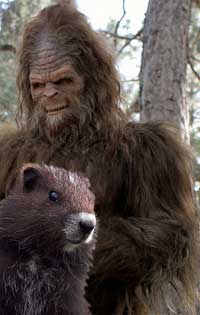The evidence was discovered late last fall, just as the first snowdrifts were piling up at the Resort.
Rhodesian cryptozoologist Khodu Modumo, who was visiting a North Island Post-Secondary Institution for a workshop, spent his free weekend roaming the high alpine areas of Mount Washington Alpine Resort, looking for rare plants to photograph, when he heard a strange whistling sound followed by a trio of three grunts.
Modumo said he recognized the high-pitched whistling as the call of a marmot, thanks to a display at the Vancouver Island Visitors’ Centre.
However, he was puzzled by the grunting noises. He continued walking just below the ridge near the Outback when he spied a curious sight: a family of three marmots was gathered at the mouth of their burrow, and 20 feet to the west, partially hidden in the tree line, was a large, man-sized creature covered in tan-coloured hair.
“The marmots were facing the trees, ya, and it appeared they were communicating something to the creature,” Modumo said. “He looked almost like an army sentry, guarding the burrow. I tried to take a picture, ya, but the light was too harsh and the creature – what do you call it here, sasquatch? It was completely in shadow.”
As the wind shifted, Modumo related, the marmots sniffed the air and must have caught his scent because they disappeared down the Marmot hole very quickly.
When Modumo looked to the tree line the creature was gone too.
Modumo told the Marmot at first he thought he had hallucinated, but when he walked toward the site there were tufts of hair scattered around the mouth of the burrow. He took a handful to examine later.
Modumo was granted permission to bring some of the hairs back to his brother’s African laboratory for DNA testing. He said the results could take a few months, and didn’t anticipate having a definitive answer until after the Marmot went to press for the summer edition.
“This is exciting, ya,” Modumo said. “Our South African cryptids are nasty creatures; my colleagues will be amazed to think a Canadian cryptid is actually helping guard a lesser species.”
The discovery was equally exciting for a supporter of the Vancouver Island marmot recovery team; where biologists always thought sasquatch was one of the four largest predators of the marmot behind cougars, wolves and golden eagles. “Boy, I guess we were really wrong,” said one biologist who was too embarrassed to give her name.
